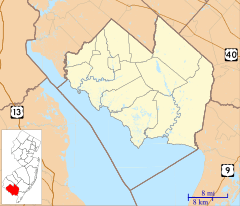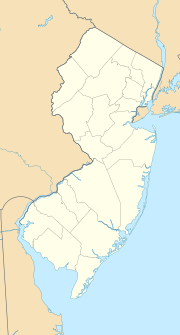Jericho, Cumberland County, New Jersey facts for kids
Quick facts for kids
Jericho, New Jersey
|
|
|---|---|

Jericho Hotel, circa 1890
|
|
| Country | |
| State | |
| County | Cumberland |
| Township | Stow Creek |
| Elevation | 9 m (30 ft) |
| Time zone | UTC−05:00 (Eastern (EST)) |
| • Summer (DST) | UTC−04:00 (EDT) |
| GNIS feature ID | 877447 |
Jericho is a small community in New Jersey, a state in the United States. It's found within Stow Creek Township in Cumberland County. An "unincorporated community" means it's a group of homes and businesses that isn't officially a town or city with its own local government.
A stream called Stow Creek flows right through Jericho. This stream eventually joins the Delaware River. You can also find a pond and a dam there.
Long ago, Jericho was a very important place, known as a "mill town." This means it had many mills that used water power to make things. It played a big role in the history of both Cumberland and Salem counties.
History of Jericho
Early Days as Gravelly Run
Jericho was first known as "Gravelly Run." It started to grow in 1680. That's when a man named John Brick bought a large piece of land. This land was about 1,000 acres (400 hectares) and was right next to Stow Creek.
John Brick built sawmills and gristmills there. Sawmills cut wood into lumber, and gristmills grind grain into flour. These mills were very important for the people living nearby.
Growth and Industry
As the mills brought more activity, other buildings appeared. The Jericho Hotel was built, offering a place for travelers to stay. In 1818, a distillery in Jericho was changed into a woolen factory. This factory made cloth from wool.
Marl and Fossils
The area around Jericho is special because of its geology. It has a type of soil called Miocene epoch marl. This marl is a soft, mud-like rock that formed millions of years ago. It is very rich in fossils, which are the preserved remains of ancient plants and animals.
In the early 1800s, farmers discovered that the marl found along Stow Creek was great for fertilizing their crops. Because of this, people started digging commercial marl pits. These pits were used to collect and sell the marl to farmers.




